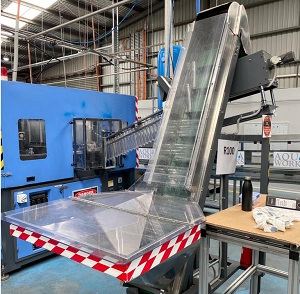Posted by Darren on Aug 12, 2022
Employees working around or near a lot of machinery are exposed to the risk of falling and getting severely injured. Therefore, it is vital to secure them to ensure employee safety and to steer clear from any expensive damage repairs or OSHA fines.
Your Legal Responsibility in Fall Protection
According to OSHA 1910.28, as an employer, you will need to provide fall protection for employees working at a height of 4' or more. This regulation is applicable for all elevated surfaces both inside and outside your property.
You are also required to offer fall protection around wall and floor openings, skylights, roof hatches, ladders, and stairways. Safety nets, industrial swing gates, guardrails systems, and personal safety device are all appropriate OSHA-compliant safety barriers. You can choose any of these for securing your machinery at your workplace.
Difference in Protecting Employees Over/Near Machinery
You have to be more diligent in protecting your employees when they are around engines. The standard rule of requiring protection at 4' or more height isn't applicable for guarding machinery.
In reality, it clearly says under OSHA 1910.28 that all employees should always be protected when working above any dangerous machinery regardless of the height. But keep this in mind, depending on the height, the type of barrier you need to pick and use would vary.
Protection at 4' or Below
 If your employee is working 4 feet or less above a dangerous device, then they would require adequate safety to prevent them from falling onto or into the engine. You can protect your employees by either installing a guardrail system, a cover over the engine, or a travel restraint system to eliminate the threat. The equipment could also pose a threat to the wellbeing of your employees even at the same height.
If your employee is working 4 feet or less above a dangerous device, then they would require adequate safety to prevent them from falling onto or into the engine. You can protect your employees by either installing a guardrail system, a cover over the engine, or a travel restraint system to eliminate the threat. The equipment could also pose a threat to the wellbeing of your employees even at the same height.
Therefore, it is essential to consult an expert regarding which safety device would be best to secure your appliances before installing any.
Protection at 4' or Above
You would need to provide additional security if your employee is working 4 feet or more above the equipment. Although safety nets and guardrail systems are helpful, you would also need to use fall arrest systems and travel restraint systems.
Guarding Do's and Don'ts
-
Don't Overlook Fall Risks:
Prevention is always better than cure. So, don't wait for an accident to arise and then face the consequences. It is better to protect your employees from any potential hazards.
-
Do Thorough Inspections:
It is essential that you get a qualified expert to thoroughly examine your appliances and the areas around it to point out any potential risks and determine the solution.
-
Don't Use Guarding that Isn't OSHA-approved:
If you do not use OSHA-approved barriers, you are endangering your employees and yourself. Therefore, regardless of what type of equipment you use, ensure it is OSHA-complaint.
-
Do Use the Right Guard for Device Safety:
Even if you use good equipment for the wrong device, it could serve as an inappropriate guard for the device. Therefore, you must always get a professional expert to inspect your device and only install a guard that fits and is perfect while also being OSHA-compliant.
-
Don't Leave Dangerous Appliances Exposed:
Doing so would expose your employees to severe risks that would only result in added expenses for damage repairs, a potential lawsuit for inadequate safety measures, and the harm caused to your employees.
-
Do Protect Engine and Guard from Unauthorised Access:
Along with protecting your employees from falls, guardrail enable you to limit the access of individuals around dangerous equipment. This ensures that anyone unauthorized can't access the area.
-
Don't Assume your Employees Know Safety Protocol:
Even if it seems like a lot to keep verifying if all your employees know how to stay clear of hazards and use the appliance safely, you should always confirm just to be safe because it is not a risk worth taking at all.
-
Do Offer Safety Training for All Employees:
As your team grows and as you get more employees on board, you should offer safety training for all employees so that they know what risks to look out for, how to keep themselves safe and use the device efficiently.
-
Don't Forget Falling Object Protection:
Another factor that you shouldn't overlook is objects like tools and equipment falling into your device. This would not only mess up your machine horribly but could also result in a life-threatening accident.
-
Don't Overcomplicate OSHA-Compliant Choices:
If you choose the right guard for your machine, then it would be easy for you to comply with the OSHA standards. Depending on the machinery, you might or might not require many safety devices.
-
Do Consult a Trustworthy Machine Guarding and Fall Protection Expert:
Your employees are counting on you to ensure their workplace isn't that dangerous even while dealing with unsafe machinery. Therefore, it is your responsibility to make them feel at ease while working hard and to make their work safer while being easier. This is only possible when you consult in a reliable professional who could suggest the right guards for your machinery.
In conclusion, your workplace doesn't necessarily need to be unsafe even when your employees are working with dangerous equipment. Using the right safety guards for your machines will ensure a smooth process while keeping your employees safe from any serious hazard.